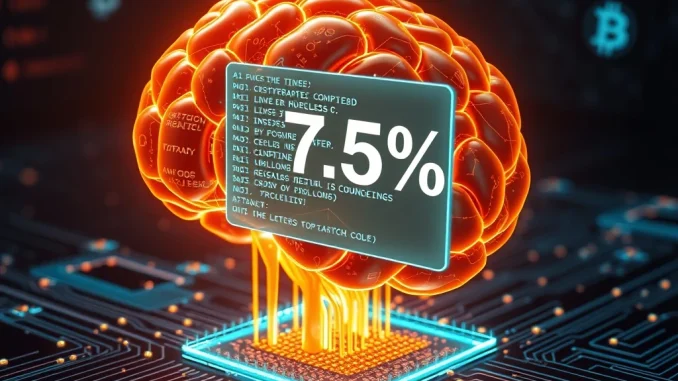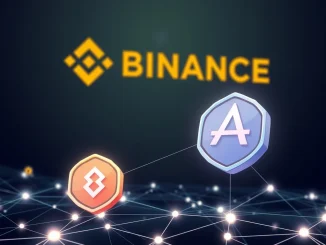
In the rapidly evolving world of technology, particularly within the cryptocurrency and blockchain sectors, the promise of Artificial Intelligence often sounds like science fiction becoming reality. From automating smart contracts to predicting market trends, AI’s potential seems limitless. However, a recent, groundbreaking competition has delivered a stark reality check. The inaugural K Prize, a rigorous AI Coding Challenge, has unveiled a shocking truth about current AI programming capabilities, leaving many to question the immediate practical readiness of these advanced systems.
The K Prize: A Stark Reality Check on AI Capabilities
Launched by the Laude Institute and Perplexity co-founder Andy Konwinski, the K Prize was designed to rigorously test AI’s ability to solve real-world software engineering problems. Unlike traditional benchmarks, this competition set out to create a ‘contamination-free’ environment, ensuring models couldn’t simply regurgitate pre-existing knowledge. The results were sobering: the highest score achieved was a mere 7.5%, awarded to Brazilian prompt engineer Eduardo Rocha de Andrade. This outcome significantly contrasts with the often-hyped narratives surrounding AI’s immediate prowess, underscoring a considerable gap between perception and reality.
Why This AI Readiness Score Matters for Blockchain
For the cryptocurrency sector, the implications of the K Prize’s findings are profound. Blockchain technology thrives on precision, security, and immutable code. AI-driven tools, whether for smart contract development, automated security audits, or complex algorithmic trading, demand an exceptionally high level of accuracy and reliability. The 7.5% top score serves as a critical indicator of current AI Readiness, suggesting that while AI can certainly assist in these areas, it is not yet capable of autonomous, high-stakes decision-making in environments where even minor errors can lead to significant financial losses or security vulnerabilities.
The competition’s methodology distinguishes itself significantly from other benchmarks like SWE-Bench. Here’s how:
- Dynamic Problem Sourcing: Instead of static problem sets, the K Prize dynamically sources GitHub issues flagged after submission deadlines. This prevents models from leveraging pre-existing knowledge.
- Contamination-Free: This unique approach aims to prevent ‘benchmark contamination,’ where models might overfit to training data that overlaps with test problems, leading to inflated scores in less rigorous evaluations.
- Real-World Focus: The challenge directly tests problem-solving skills against novel, real-world software engineering issues, providing a more accurate assessment of generalization capabilities.
Understanding the Discrepancy: K Prize vs. Traditional Benchmarks
The low score from the K Prize stands in stark contrast to scores reported on benchmarks like SWE-Bench, which has seen top scores of 75% on its ‘Verified’ test and 34% on the more challenging ‘Full’ test. This significant discrepancy highlights a crucial concern: are higher scores on traditional benchmarks genuinely indicative of AI’s capabilities, or are they inflated due to data contamination?
Princeton researcher Sayash Kapoor emphasized this point, noting that without experiments like the K Prize, it remains unclear whether low scores stem from contaminated data or the inherent difficulty of sourcing truly novel issues. Andy Konwinski, a key architect of the K Prize, firmly stated, ‘We’re glad we built a benchmark that is actually hard,’ reinforcing the competition’s goal of providing an honest assessment of AI’s current state.
Democratizing AI Innovation for Robust Software Engineering AI
Konwinski’s vision extends beyond just assessment. He has pledged $1 million for the first open-source model to achieve over 90% accuracy in the K Prize. This generous incentive reflects a broader push toward democratizing AI innovation, encouraging the development of robust, open-source solutions rather than relying solely on proprietary systems dominated by large tech firms. This approach is particularly relevant for Software Engineering AI, where transparency and collaborative development can lead to more secure and reliable tools.
By favoring open-source models and limiting computational resources, the K Prize promotes accessibility for smaller teams and independent researchers. This aligns with the competition’s goal of fostering practical AI applications, especially in fields like blockchain, where code precision and security are non-negotiable. Konwinski further criticized the ‘hype’ surrounding AI’s capabilities, stating, ‘If you listen to the hype, it’s like we should be seeing AI doctors and AI lawyers and AI software engineers, and that’s just not true.’ The K Prize’s results, he argued, are a necessary reality check.
The Path Forward: Iterative Refinement and Human Oversight
The K Prize’s iterative design, with plans to update test problems every few months, aims to create a continuously evolving challenge that demands true adaptability from AI models. Konwinski anticipates that as the competition progresses, participants will adapt, fostering breakthroughs in generalization and real-world applicability. This iterative process is essential for pushing AI beyond its current limits and toward ‘genuine mastery of complex tasks.’
For the cryptocurrency sector, the message is clear: while AI can be a powerful assistant, human oversight remains absolutely critical. Especially in Blockchain AI applications, where even minor errors can lead to significant financial or operational risks, the need for skilled human developers and auditors cannot be overstated. The K Prize represents a pivotal step in redefining how AI is evaluated, prioritizing transparency, accessibility, and real-world relevance. While the initial results are sobering, they underscore the need for continued, rigorous testing and a collaborative approach to AI development. As the competition progresses, its impact on shaping the future of AI in critical technological fields will become increasingly evident.
Frequently Asked Questions (FAQs)
What is the K Prize AI Coding Challenge?
The K Prize is a new, rigorous AI coding challenge launched by the Laude Institute and Perplexity co-founder Andy Konwinski. It’s designed to test AI’s real-world problem-solving skills in software engineering by using dynamically sourced, ‘contamination-free’ GitHub issues.
Why was the 7.5% top score in the K Prize considered concerning?
The 7.5% top score highlights a significant gap between the perceived potential of AI and its actual practical readiness, especially when compared to higher scores on less rigorous benchmarks. It suggests current AI models struggle with true generalization and solving novel, real-world coding problems autonomously.
How does the K Prize differ from other AI benchmarks like SWE-Bench?
The K Prize distinguishes itself by sourcing test problems dynamically from GitHub issues flagged after submission deadlines, ensuring a ‘contamination-free’ benchmark. This prevents AI models from inadvertently training on or leveraging pre-existing knowledge of the test data, unlike some traditional benchmarks.
What are the implications of the K Prize results for Blockchain AI?
For blockchain, the results emphasize that while AI can assist in areas like smart contract development or audits, it’s not yet capable of autonomous, high-stakes decision-making. The need for human oversight remains critical to ensure reliability and security in blockchain applications where errors can have significant consequences.
What is the long-term vision for the K Prize?
The K Prize aims to iteratively refine AI’s problem-solving abilities by continuously updating test problems. Andy Konwinski has also pledged $1 million for the first open-source model to achieve over 90% accuracy, encouraging the development of democratized, robust, and resource-efficient AI solutions.



